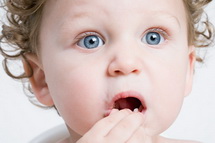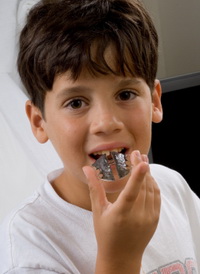
Dental Emergencies
 Toothache:
Clean the area of the affected tooth. Rinse the mouth thoroughly with warm water or use dental floss to dislodge any food that may be impacted. If the pain still exists, contact your child's dentist. Do not place aspirin or heat on the gum or on the aching tooth. If the face is swollen, apply cold compresses and contact your dentist immediately.
Toothache:
Clean the area of the affected tooth. Rinse the mouth thoroughly with warm water or use dental floss to dislodge any food that may be impacted. If the pain still exists, contact your child's dentist. Do not place aspirin or heat on the gum or on the aching tooth. If the face is swollen, apply cold compresses and contact your dentist immediately.
Cut or Bitten Tongue, Lip or Cheek: Apply ice to injured areas to help control swelling. If there is bleeding, apply firm but gentle pressure with a gauze or cloth. If bleeding cannot be controlled by simple pressure, call a doctor or visit the hospital emergency room.
Knocked Out Permanent Tooth: If possible, find the tooth. Handle it by the crown, not by the root. You may rinse the tooth with water only. DO NOT clean with soap, scrub or handle the tooth unnecessarily. Inspect the tooth for fractures. If it is sound, try to reinsert it in the socket. Have the patient hold the tooth in place by biting on a gauze. If you cannot reinsert the tooth, transport the tooth in a cup containing the patient’s saliva or milk. If the patient is old enough, the tooth may also be carried in the patient’s mouth (beside the cheek). The patient must see a dentist IMMEDIATELY! Time is a critical factor in saving the tooth.
Knocked Out Baby Tooth: Contact your pediatric dentist during business hours. This is not usually an emergency, and in most cases, no treatment is necessary.
Chipped or Fractured Permanent Tooth: Contact your Pediatric Dentist at first opportunity during business hours
unless you observe that the nerve is exposed or more than half of the crown of the tooth is missing. If the nerve is exposed you will see bleeding from the center of the tooth (not the gum line). Contact your Pediatric Dentist immediately in these two cases.
Chipped or Fractured Baby Tooth: Contact your pediatric dentist.
Severe Blow to the Head: Take your child to the nearest hospital emergency room immediately.
Possible Broken or Fractured Jaw: Keep the jaw from moving and take your child to the nearest hospital emergency room.

Dental Radiographs (X-Rays)
Radiographs (X-Rays) are a vital and necessary part of your child’s dental diagnostic process. Without them, certain dental conditions can and will be missed.

Radiographs detect much more than cavities. For example,
radiographs may be needed to survey erupting teeth, diagnose
bone diseases, evaluate the results of an injury, or plan
orthodontic treatment. Radiographs allow dentists to diagnose
and treat health conditions that cannot be detected during a
clinical examination. If dental problems are found and treated
early, dental care is more comfortable for your child and more
affordable for you.
The American Academy of Pediatric Dentistry recommends
radiographs and examinations every six months for children with
a high risk of tooth decay. On average, most pediatric dentists
request radiographs approximately once a year. Approximately
every 3 years, it is a good idea to obtain a complete set of
radiographs, either a panoramic and bitewings or periapicals and
bitewings.
Pediatric dentists are particularly careful to minimize the
exposure of their patients to radiation. With contemporary
safeguards, the amount of radiation received in a dental X-ray
examination is extremely small. The risk is negligible. In fact,
the dental radiographs represent a far smaller risk than an
undetected and untreated dental problem. Lead body aprons and
shields will protect your child. Today’s equipment filters out
unnecessary x-rays and restricts the x-ray beam to the area of
interest. High-speed film and proper shielding assure that your
child receives a minimal amount of radiation exposure.

Does Your Child Grind
His Teeth At Night? (Bruxism)
Parents are often concerned about the nocturnal grinding of teeth (bruxism). Often, the first indication is the noise created by the child grinding on their teeth during sleep. Or, the parent may notice wear to the primary teeth. The majority of cases of pediatric bruxism do not require treatment. If excessive wear occurs however, a mouth guard may be indicated. The good news is that most children outgrow bruxism. The grinding decreases between the ages of 6-9 and most children stop grinding between ages 9-12.

Thumb Sucking
 Sucking
is a natural reflex and infants and young children may use
thumbs, fingers, pacifiers and other objects on which to suck.
It may make them feel secure and happy, or provide a sense of
security at difficult periods. Since thumb sucking is relaxing,
it may induce sleep.
Sucking
is a natural reflex and infants and young children may use
thumbs, fingers, pacifiers and other objects on which to suck.
It may make them feel secure and happy, or provide a sense of
security at difficult periods. Since thumb sucking is relaxing,
it may induce sleep.
Thumb sucking that persists beyond the eruption of the
permanent teeth can cause problems with the proper growth of the
mouth and tooth alignment. How intensely a child sucks on
fingers or thumbs will determine whether or not dental problems
may result. Children who rest their thumbs passively in their
mouths are less likely to have difficulty than those who
vigorously suck their thumbs.
Children should cease thumb sucking by the time their permanent front teeth are ready to erupt. Many children are able to stop by themselves. Some children, however, require a habit appliance. Habit appliances are highly successful if and when the child is ready; usually at about the time he or she starts school. Habit appliances should not be attempted on young, pre-school age children who are not emotionally ready. Your Pediatric Dentist will help you evaluate you child’s readiness if such an appliance is indicated.
Pacifiers are no substitute for thumb sucking. They can
affect the teeth essentially the same way as sucking fingers and
thumbs. However, use of the pacifier can be controlled and
modified more easily than the thumb or finger habit. If you have
concerns about thumb sucking or use of a pacifier, consult your
pediatric dentist.
A few suggestions to help your child get through thumb
sucking:
- Children often suck their thumbs when feeling insecure.
Focus on correcting the cause of anxiety, instead of the
thumb sucking.
- Children who are sucking for comfort will feel less of a
need when their parents provide comfort.
- Reward children when they refrain from sucking during
difficult periods, such as when being separated from their
parents.
- Your pediatric dentist can encourage children to stop
sucking and explain what could happen if they continue.
- If these approaches don’t work, remind the children of
their habit by bandaging the thumb or putting a sock on the
hand at night. Your pediatric dentist may recommend the use
of a mouth appliance.

What Is Pulp Therapy?
Pulp therapy is the removal of all or part of the nerve of a diseased tooth when the decay is advanced and the nerve tissue is involved. It involves removal of diseased nerve tissue, disinfection of the nerve chamber inside the tooth, and the filling of the nerve chamber with a resorbable material. A final restoration will also be placed. Pulp Therapy is sometimes also indicated in dental trauma when the nerve is damaged or exposed.
What Is The Best
Time For Orthodontic Treatment?
 The timing of Orthodontic Treatment is dependent on the nature of the orthodontic problem as well as the age of the child. In certain cases, such as severe crowding with constricted jaws or jaw malrelationships, earlier two-phase treatment might be the best option. In other cases it is appropriate to wait for all of the baby teeth to exfoliate and most of the permanent teeth to be in.
The timing of Orthodontic Treatment is dependent on the nature of the orthodontic problem as well as the age of the child. In certain cases, such as severe crowding with constricted jaws or jaw malrelationships, earlier two-phase treatment might be the best option. In other cases it is appropriate to wait for all of the baby teeth to exfoliate and most of the permanent teeth to be in.
Stage I – Early Treatment: This period of treatment
encompasses ages 2 to 6 years. At this young age, we are
concerned with underdeveloped dental arches, the premature loss
of primary teeth, and harmful habits such as finger or thumb
sucking. Treatment initiated in this stage of development is
often very successful and many times, though not always, can
eliminate the need for future orthodontic/orthopedic treatment.
Stage II – Mixed Dentition: This period covers the
ages of 6 to 12 years, with the eruption of the permanent
incisor (front) teeth and 6 year molars. Treatment concerns deal
with jaw malrelationships and dental realignment problems. This
is an excellent stage to start treatment, when indicated, as
your child’s hard and soft tissues are usually very responsive
to orthodontic or orthopedic forces.
Stage III – Adolescent Dentition: This stage deals
with the permanent teeth and the development of the final bite
relationship.

Early Infant Oral Care
Perinatal &
Infant Oral Health

The American Academy of Pediatric Dentistry (AAPD) recommends
that all pregnant women receive oral healthcare and counseling
during pregnancy. Research has shown evidence that periodontal
disease can increase the risk of preterm birth and low birth
weight. Talk to your doctor or dentist about ways you can
prevent periodontal disease during pregnancy.
Additionally, mothers with poor oral health may be at a
greater risk of passing the bacteria which causes cavities to
their young children. Mother's should follow these simple steps
to decrease the risk of spreading cavity-causing bacteria:
- Visit your dentist regularly.
- Brush and floss on a daily basis to reduce bacterial
plaque.
- Proper diet, with the reduction of beverages and foods
high in sugar & starch.
- Use a fluoridated toothpaste recommended by the ADA and
rinse every night with an alocohol-free, over-the-counter
mouth rinse with .05 % sodium fluoride in order to reduce
plaque levels.
- Don't share utensils, cups or food which can cause the
transmission of cavity-causing bacteria to your children.
- Use of xylitol chewing gum (4 pieces per day by the
mother) can decrease a child’s caries rate.
When Will My Baby
Start Getting Teeth?
Teething, the process of baby (primary) teeth coming through the gums into the mouth, is variable among individual babies. Some babies get their teeth early and some get them late. In general, the first baby teeth to appear are usually the lower front (anterior) teeth and they usually begin erupting between the age of 6-8 months.
See "Eruption of Your
Child’s Teeth" for more details.
Baby Bottle Tooth
Decay (Early Childhood Caries)

One serious form of decay among young children is baby bottle
tooth decay. This condition is caused by frequent and long
exposures of an infant’s teeth to liquids that contain sugar.
Among these liquids are milk (including breast milk), formula,
fruit juice and other sweetened drinks.
Putting a baby to bed for a nap or at night with a bottle
other than water can cause serious and rapid tooth decay. Sweet
liquid pools around the child’s teeth giving plaque bacteria an
opportunity to produce acids that attack tooth enamel. If you
must give the baby a bottle as a comforter at bedtime, it should
contain only water. If your child won't fall asleep without the
bottle and its usual beverage, gradually dilute the bottle's
contents with water over a period of two to three weeks.
After each feeding, wipe the baby’s gums and teeth with a
damp washcloth or gauze pad to remove plaque. The easiest way to
do this is to sit down, place the child’s head in your lap or
lay the child on a dressing table or the floor. Whatever
position you use, be sure you can see into the child’s mouth
easily.

Adolescent Dentistry

Tongue Piercing - Is It Really
Cool?
You might not be surprised anymore to see people with pierced
tongues, lips or cheeks, but you might be surprised to know just
how dangerous these piercings can be.
There are many risks involved with oral piercings, including
chipped or cracked teeth, blood clots, blood poisoning, heart
infections, brain abscess, nerve disorders (trigeminal
neuralgia), receding gums or scar tissue. Your mouth contains
millions of bacteria, and infection is a common complication of
oral piercing. Your tongue could swell large enough to close off
your airway!
Common symptoms after piercing include pain, swelling,
infection, an increased flow of saliva and injuries to gum
tissue. Difficult-to-control bleeding or nerve damage can result
if a blood vessel or nerve bundle is in the path of the needle.
So follow the advice of the American Dental Association and
give your mouth a break – skip the mouth jewelry.
Tobacco - Bad News In Any Form
Tobacco in any form can jeopardize your child’s health and
cause incurable damage. Teach your child about the dangers of
tobacco.
Smokeless tobacco, also called spit, chew or snuff, is often
used by teens who believe that it is a safe alternative to
smoking cigarettes. This is an unfortunate misconception.
Studies show that spit tobacco may be more addictive than
smoking cigarettes and may be more difficult to quit. Teens who
use it may be interested to know that one can of snuff per day
delivers as much nicotine as 60 cigarettes. In as little as
three to four months, smokeless tobacco use can cause
periodontal disease and produce pre-cancerous lesions called
leukoplakias.
If your child is a tobacco user you should watch for the
following that could be early signs of oral cancer:
- A sore that won’t heal.
- White or red leathery patches on the lips, and on or
under the tongue.
- Pain, tenderness or numbness anywhere in the mouth or
lips.
- Difficulty chewing, swallowing, speaking or moving the
jaw or tongue; or a change in the way the teeth fit
together.
Because the early signs of oral cancer usually are not
painful, people often ignore them. If it’s not caught in the
early stages, oral cancer can require extensive, sometimes
disfiguring, surgery. Even worse, it can kill.
Help your child avoid tobacco in any form. By doing so, they
will avoid bringing cancer-causing chemicals in direct contact
with their tongue, gums and cheek.





 Look!
My Tooth is Loose!
Look!
My Tooth is Loose! Toothache:
Clean the area of the affected tooth. Rinse the mouth thoroughly with warm water or use dental floss to dislodge any food that may be impacted. If the pain still exists, contact your child's dentist. Do not place aspirin or heat on the gum or on the aching tooth. If the face is swollen, apply cold compresses and contact your dentist immediately.
Toothache:
Clean the area of the affected tooth. Rinse the mouth thoroughly with warm water or use dental floss to dislodge any food that may be impacted. If the pain still exists, contact your child's dentist. Do not place aspirin or heat on the gum or on the aching tooth. If the face is swollen, apply cold compresses and contact your dentist immediately.
 Sucking
is a natural reflex and infants and young children may use
thumbs, fingers, pacifiers and other objects on which to suck.
It may make them feel secure and happy, or provide a sense of
security at difficult periods. Since thumb sucking is relaxing,
it may induce sleep.
Sucking
is a natural reflex and infants and young children may use
thumbs, fingers, pacifiers and other objects on which to suck.
It may make them feel secure and happy, or provide a sense of
security at difficult periods. Since thumb sucking is relaxing,
it may induce sleep.
 The timing of Orthodontic Treatment is dependent on the nature of the orthodontic problem as well as the age of the child. In certain cases, such as severe crowding with constricted jaws or jaw malrelationships, earlier two-phase treatment might be the best option. In other cases it is appropriate to wait for all of the baby teeth to exfoliate and most of the permanent teeth to be in.
The timing of Orthodontic Treatment is dependent on the nature of the orthodontic problem as well as the age of the child. In certain cases, such as severe crowding with constricted jaws or jaw malrelationships, earlier two-phase treatment might be the best option. In other cases it is appropriate to wait for all of the baby teeth to exfoliate and most of the permanent teeth to be in.



